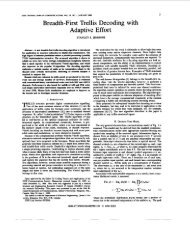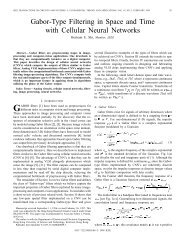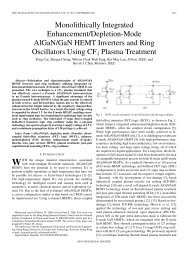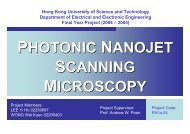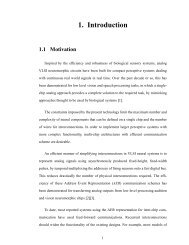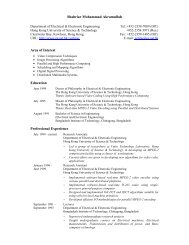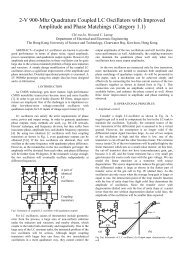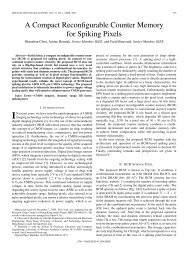Microring and microdisk resonator integrated circuits on a silicon chip
Microring and microdisk resonator integrated circuits on a silicon chip
Microring and microdisk resonator integrated circuits on a silicon chip
Create successful ePaper yourself
Turn your PDF publications into a flip-book with our unique Google optimized e-Paper software.
B (V B ) of 0 V, 1.0 V, <str<strong>on</strong>g>and</str<strong>on</strong>g> 1.1 V. Similarly, we observe an ER of ~13 dB up<strong>on</strong> V B = 1.1 V, an enhancement comparedwith that of ~4 dB up<strong>on</strong> V B = 0 V.Fig. 5. (a) Electrical input data stream with ±1-V signal levels applied across node B. (b) <str<strong>on</strong>g>and</str<strong>on</strong>g> (c) Measured 200-Mbps NRZ opticalwaveforms at a probe wavelength in the vicinity of a res<strong>on</strong>ance under V A = 0 V, <str<strong>on</strong>g>and</str<strong>on</strong>g> V A = 1.2 V. (d) Electrical input data stream with±1-V signal levels applied across node A. (e) <str<strong>on</strong>g>and</str<strong>on</strong>g> (f) Measured 200-Mbps NRZ optical waveforms at a probe wavelength in thevicinity of a res<strong>on</strong>ance under V B = 0 V, <str<strong>on</strong>g>and</str<strong>on</strong>g> V B = 1.1 V.In order to examine the modulator resp<strong>on</strong>se, we apply a 200-Mbps NRZ electrical driving signal with ±1-V signal levelsat node B, as shown in Fig. 5(a), while launching a probe wavelength in the vicinity of the res<strong>on</strong>ance. Fig. 5(b) showsthe modulated optical waveform for V A = 0 V. We observe <strong>on</strong>ly ~55% modulati<strong>on</strong> depth which is c<strong>on</strong>sistent with theER of ~4 dB. Fig. 5(c) shows the modulated optical waveform for V A = 1.2 V. The modulati<strong>on</strong> depth is improved to~90% which is c<strong>on</strong>sistent with the enhanced ER of ~12 dB.Similarly, we also forward-bias node B (V B ) <str<strong>on</strong>g>and</str<strong>on</strong>g> modulate node A by applying the same electrical driving signal, asshown in Fig. 5(d). Figs. 5(e) <str<strong>on</strong>g>and</str<strong>on</strong>g> 5(f) show the modulated optical waveforms for V B = 0 V <str<strong>on</strong>g>and</str<strong>on</strong>g> V B = 1.1 V. Weobserve that the modulati<strong>on</strong> depth improves from ~50% (V B = 0 V) to ~85% (V B = 1.1 V). We remark that the opticalwaveforms from node A modulati<strong>on</strong> exhibit shorter rise <str<strong>on</strong>g>and</str<strong>on</strong>g> fall times than those from node B modulati<strong>on</strong> (see Figs. 5(b)<str<strong>on</strong>g>and</str<strong>on</strong>g> 5(c)). We attribute this improvement to relatively less free-carriers diffusi<strong>on</strong> escape near the two ends of the l<strong>on</strong>gdiode-<str<strong>on</strong>g>integrated</str<strong>on</strong>g> U-bend waveguide. Thus, most of the free carriers can be swept out up<strong>on</strong> reverse bias. In c<strong>on</strong>trast,modulating the relatively short arcs of the partially wrapped microring allows more carriers to escape by diffusi<strong>on</strong>, <str<strong>on</strong>g>and</str<strong>on</strong>g>thereby slowing down the modulati<strong>on</strong> resp<strong>on</strong>se [23, 24].4. SILICON MICRODISK ELECTRO-OPTIC MODULATORS USING SELECTIVELYINTEGRATED DEPLETION-TYPE SCHOTTKY DIODESIn this secti<strong>on</strong>, we numerically examine our recently proposed class of silic<strong>on</strong> EO modulators using <str<strong>on</strong>g>microdisk</str<strong>on</strong>g> <str<strong>on</strong>g>res<strong>on</strong>ator</str<strong>on</strong>g>swith selectively <str<strong>on</strong>g>integrated</str<strong>on</strong>g> depleti<strong>on</strong>-type Schottky diodes [36]. Compared with microring <str<strong>on</strong>g>res<strong>on</strong>ator</str<strong>on</strong>g>s, <str<strong>on</strong>g>microdisk</str<strong>on</strong>g><str<strong>on</strong>g>res<strong>on</strong>ator</str<strong>on</strong>g>s applied as EO modulators offer three key advantages. On the optics fr<strong>on</strong>t, <str<strong>on</strong>g>microdisk</str<strong>on</strong>g> <str<strong>on</strong>g>res<strong>on</strong>ator</str<strong>on</strong>g>s have no innersidewall scattering loss, <str<strong>on</strong>g>and</str<strong>on</strong>g> thereby whispering-gallery modes (WGMs) that graze al<strong>on</strong>g the <str<strong>on</strong>g>microdisk</str<strong>on</strong>g> rim are ofintrinsically higher Q than the microring res<strong>on</strong>ances. On the fabricati<strong>on</strong> end, <str<strong>on</strong>g>microdisk</str<strong>on</strong>g> structures eliminate theundesirable polarizati<strong>on</strong>-mode mixing <str<strong>on</strong>g>and</str<strong>on</strong>g> cavity losses due to fabricati<strong>on</strong> error induced microring waveguide width n<strong>on</strong>uniformity.On the electrical fr<strong>on</strong>t, our numerical simulati<strong>on</strong> suggests that depleti<strong>on</strong>-type EO modulators using<str<strong>on</strong>g>microdisk</str<strong>on</strong>g> structures have higher modulati<strong>on</strong> b<str<strong>on</strong>g>and</str<strong>on</strong>g>width than microring structures.


